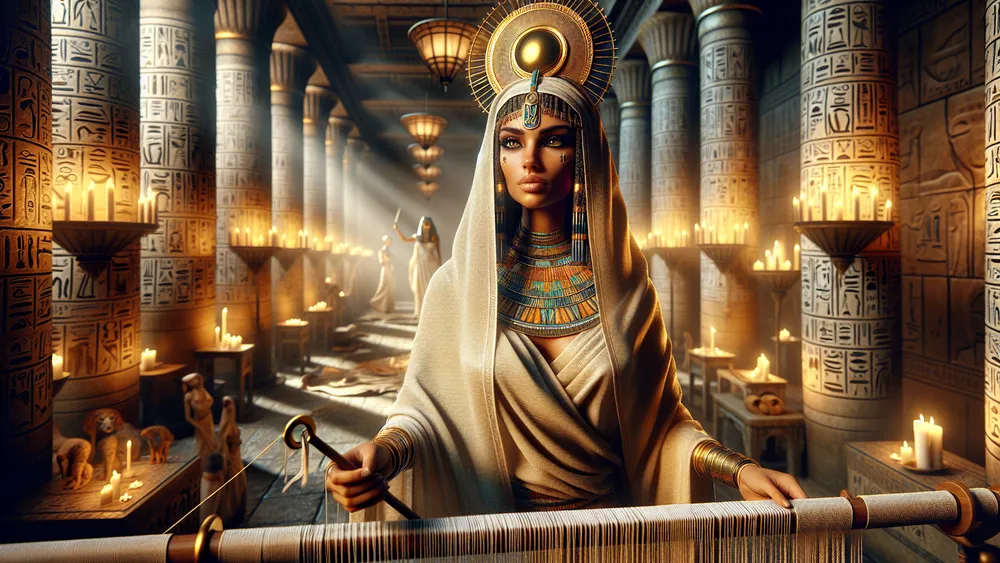Tayet: Ancient Egyptian Goddess Of Weaving
Consider being in ancient Egypt; it was a place that had really big buildings, detailed art, and deep stories about gods. Among these gods, Tayet is special because she is the goddess of weaving. Like how technology is a big part of our lives today, in ancient Egypt, weaving was very important for making clothes, sheets, and special ceremony outfits.
Key Points:
- Tayet is the Ancient Egyptian goddess of Weaving and Textiles.
- She was crucial for making clothes for everyday use and religious events.
- Tayet is often linked with other Egyptian gods like Isis and Nephthys.
- Weaving was a key economic activity in ancient Egypt, and Tayet was respected for her skills.
- Old Egyptian rituals included giving cloth offerings and saying prayers for good textile making.
- Tayet’s legacy inspires today’s weavers and textile artists to bring back old techniques.
- Tayet’s role in Egyptian mythology was to oversee and bless the creation of textiles, giving them protective and magical qualities.
This blog post will look into the interesting world of Tayet, talking about where she came from, what stories say about her, and why she still matters. It starts with old writings about her, showing symbols and talking about the special ceremonies for her, so you can understand how important Tayet was.
And today, old weaving methods are getting popular again, taking ideas from the goddess herself. Let’s start learning and follow the threads of Tayet’s tale.
Tayet: Overview and Key Facts
| Key Point | Description |
|---|---|
| Name | Tayet (also spelled Tayt or Tait) |
| Role | Goddess of Weaving and Textiles |
| Representation | Often connected to the loom and other tools used in weaving |
| Earliest Mentions | Found in Pyramid Texts and Coffin Texts from the Old Kingdom times |
| Importance | Crucial to making clothes for everyday use and religious events |
| Relationships | Linked to gods like Isis and Nephthys, often working together with them |
| Impact on Culture | Weaving was a key economic activity, and Tayet was respected for her weaving skills |
| Present-Day Legacy | Inspires today’s weavers and textile artists, with old techniques being brought back |
| Ceremonies and Offerings | Included giving cloth offerings and saying prayers for good weaving |
| Depictions | Not often seen in art, but when shown, she is usually with weaving tools |
How Tayet Came to Be
To know where Tayet came from and why she is important in old Egyptian stories, we must look at the old writings and tales that first spoke about her.
The History of Tayet
The first mentions of Tayet are in Pyramid Texts and Coffin Texts, which come from the Old Kingdom period in ancient Egypt, around 2400-2100 BCE. These texts, written on pyramid walls and coffins, show Tayet’s job as the goddess of weaving, a very important craft in ancient Egyptian life. Weaving was not just an everyday job; it was necessary for making clothes for daily wear, special ceremonies, and burial wraps. Think of how important clothes-making is today, and you can start to see this.
Tayet did more than just make textiles; she was thought to give the fabrics protective and magical powers. In ancient Egypt, where the afterlife was extremely important, Tayet’s work was seen as very important for ensuring a safe trip to the next world. Important points about Tayet’s historical role include:
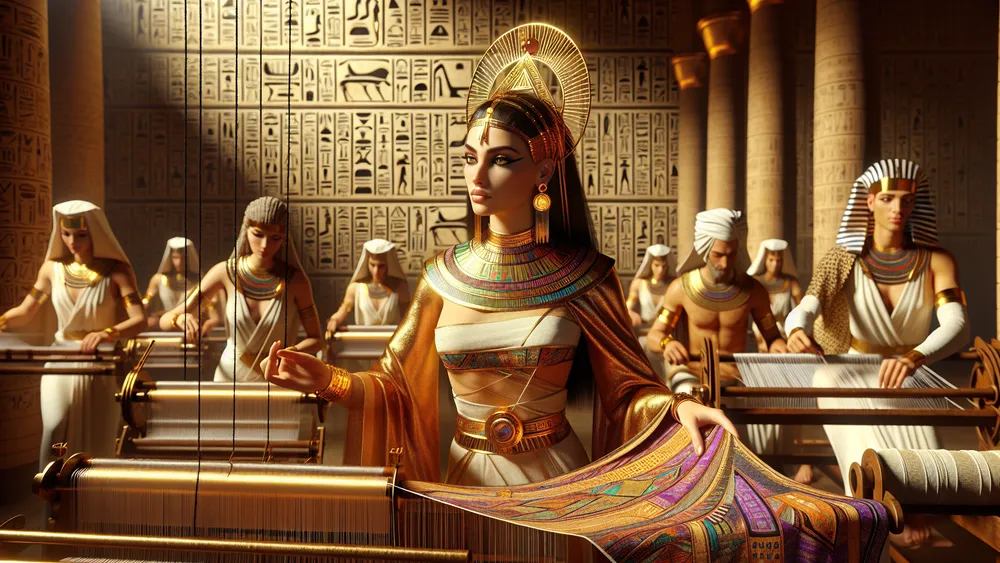
- First Mentions: Found in Pyramid Texts and Coffin Texts.
- Job in Society: Necessary for making clothes for daily life and religious ceremonies.
- Magical Powers: Thought to give fabrics protective and magic qualities.
Tayet, the goddess of Egyptian mythology, played a crucial role in society by overseeing the craft of creating textiles with magical properties, essential for everyday wear and religious rituals during the Old Kingdom period.
Tayet in Egyptian Stories
In old Egyptian stories, Tayet is often shown in tales that focus on her weaving skill and her important role. One well-known story is about her working together with Isis and Nephthys, who were two very honored goddesses in Egyptian belief.
In those stories, Tayet is often asked to weave the linen strips for wrapping mummies, which is a very important part of making sure the dead have a safe trip to the next life.
Think of a team doing a significant job, where each person’s different skills are needed for it to work. The same way, Tayet’s weaving was necessary in the important rituals done by Isis and Nephthys, showing her key part in these holy tales.
Tayet’s connections with other gods further show her importance. She is often linked with Isis, who is the goddess of magic and mothers, and Nephthys, who is the goddess of sadness and protection. These goddesses made a strong group, each bringing their special skills to the work. Tayet is often shown with the loom and weaving tools, showing her control over making textiles and other crafts. In Egyptian stories, these tools were not just simple items but had magic powers, showing Tayet’s power to make protective and holy clothes. Main points about Tayet in these stories include:
- Working with Isis and Nephthys: Important in mummification and holy rituals.
- Symbolism: Shown with the loom and weaving tools.
- Role in Stories: Key to tales about making protective and magical textiles.
Tayet’s Part in Weaving and Cloth Making
To really understand Tayet’s impact, it is very important to look at the old ways of weaving and the meaning of cloth making in old Egypt.
How They Wove Things Back Then
In old Egypt, weaving was a very grown craft that used specific ways and stuff. The main thing they used was flax, which they grew by the Nile River and changed into linen, a common cloth. Weavers used vertical looms, which let them make big pieces of cloth quickly. They turned flax fibers into thread, then wove the thread into cloth on the loom.
Think of the complicated work of hand-making a blanket today, and you can start to see the skill and hard work in old Egyptian weaving. The linen made was so good that it was used for both daily wear and fancy burial cloths.
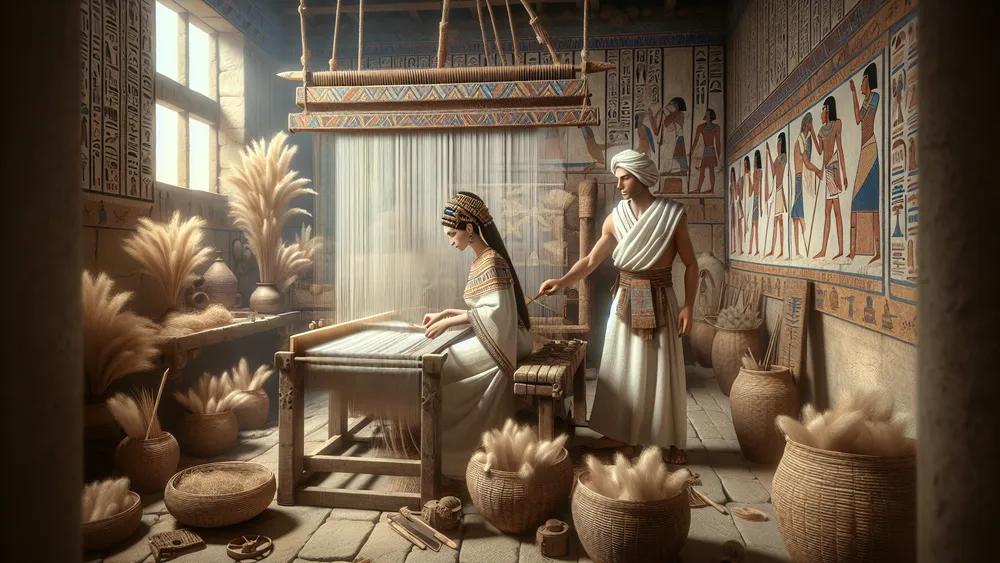
Weaving was important culturally and economically in old Egyptian life. It was not only a home job but also a key business that helped the economy. Linen was used for many things, from clothes to household items to religious and burial practices. Being able to make good linen made people proud and showed social rank. Over time, weaving changed, showing bigger social changes.
In the Old Kingdom, weaving was mainly a home job, but by the New Kingdom, it became more industrial, with workshops making cloth on a bigger scale. This change shows how society went from mainly farming to having more complex economic systems. Key parts of old Egyptian weaving include:
- Materials: Mostly flax, which they used to make linen.
- Techniques: Vertical looms and hand-turning of flax fibers.
- Cultural and Economic Role: Important for daily life, religious practices, and the economy.
Tayet as the Weaving Goddess
Tayet’s role as goddess of weaving in old Egyptian stories was complex and deeply respected. She watched over making textiles, especially linen, a key material in daily and religious life. Tayet was shown with weaving tools like the spindle and loom, showing her control over this important craft. Her godly powers could give fabrics protective and magical features, making her very important in rituals, mainly those for mummification and the next life.
Imagine a top craftsperson whose work is functional but also holds deep meaning; this is how old Egyptians saw Tayet.
When you look at Tayet and other weaving goddesses from different places, interesting similarities and differences show up. For example, Arachne in Greek stories was a human weaver turned into a spider by the goddess Athena, showing the tricky and sometimes dangerous nature of weaving. In Norse stories, Frigg, Odin’s wife, was also linked with weaving and spinning, often shown as a caring figure who wove the fates of people. These goddesses, like Tayet, were respected for their craft and their power to affect both the real and spiritual worlds. Here is a table to compare Tayet, Arachne, and Frigg:
| Goddess | Culture | Role in Weaving | Attributes and Symbolism |
|---|---|---|---|
| Tayet | Egyptian | Watches over making textiles, especially linen | Weaving tools, gives fabrics protective and magical features |
| Arachne | Greek | Human weaver turned into a spider | Detailed weaving, turned by Athena |
| Frigg | Norse | Linked with weaving and spinning | Caring figure, weaver of fates |
Rituals and Gifts for Tayet
In old Egypt, rituals and gifts for Tayet were very important to make sure weaving went well. They often gave her very nicely woven linen, small statues, and food at her altars. The people believed that Tayet’s powers would make their fabrics better and stronger. Think how nowadays an artist might look for success by dedicating their first work to somebody special or a higher being; in similar ways, old weavers wanted Tayet’s favor by these actions. The reason these things mattered was because they could get divine protection and skill, making the weaving not only successful but also full of special meaning. Key parts of these rituals were:
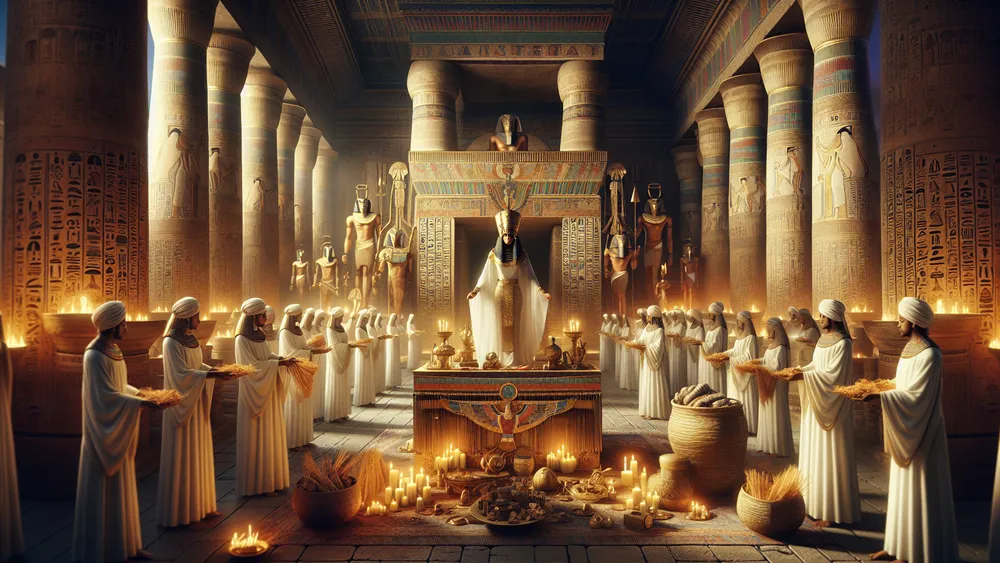
- Gifts: Very nice linen, small statues, and food.
- Reason: To get Tayet’s help for good weaving.
- Importance: Making textiles good, strong, and having special protection.
Tayet’s Impact on Today
Knowing how important Tayet was long ago lets us see her lasting effect now.
Tayet in Today’s Books and Movies
Tayet shows up in today’s media, like books, movies, and TV shows, proving she has left a lasting impact. She isn’t always the main character like other gods, but her role as the weaving goddess has sparked many creative stories. For example, in the book “The Weavers of Time,” Tayet helps the main character learn weaving. Another one, in the TV show “Ancient Mysteries,” has an episode about Egyptian stories and Tayet’s part in weaving cloth. You might find it interesting that these stories often show her as a protector and a carer, just like how modern tales show the wisdom of teachers and guardians. Some key stories with Tayet are:
- “The Weavers of Time”: A book where Tayet helps the main character with weaving.
- “Ancient Mysteries”: A TV show episode about Tayet’s part in weaving.
- “Threads of Eternity”: A comic book that shows Tayet in both old and new times.
Tayet’s presence in various forms of media as the goddess of the loom has inspired creative stories portraying her as a protector and caregiver, reflecting the wisdom of teachers and guardians in modern tales.
Bringing Back Old Weaving Ways
These days, old Egyptian weaving methods get brought back and kept by certain workers and history fans who carefully read old writings and look at old items. These actions use things like flax and make old-style looms again to make cloth that looks a lot like those from very long ago.
You may be interested to learn this bringing back is much like what chefs do when they use old recipes, mixing old ways with new love. Tayet, the weaving goddess, still moves modern weavers and cloth makers who see her as a sign of skill and new ideas.
This can be seen by how these people try to keep old ways and add some new style, making sure weaving stays both an old and new craft.
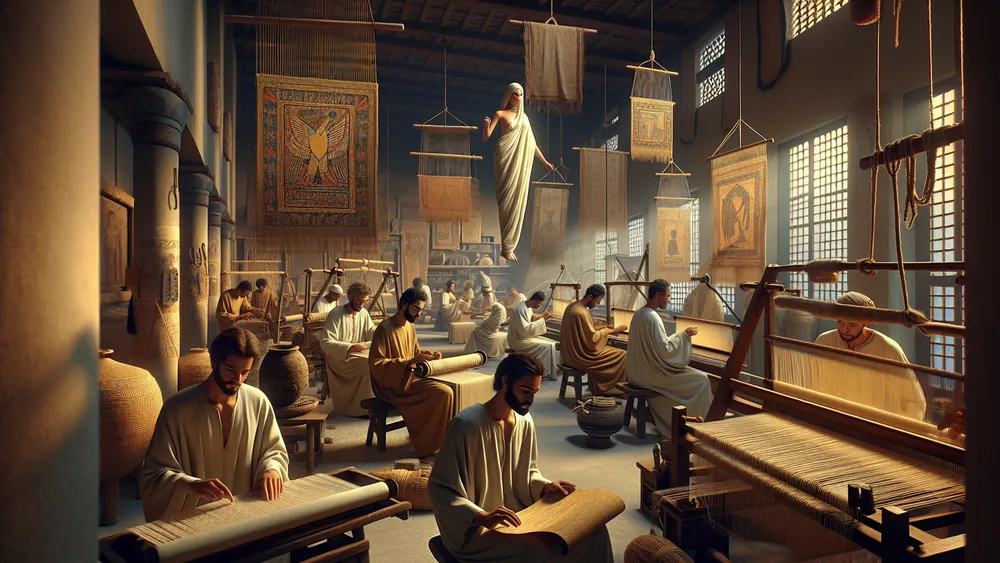
Pantheon of Egyptian Mythology Gods
The group of Egyptian gods is a huge and detailed mix of gods and goddesses, each having their own special traits and stories. You might find it interesting that these gods and goddesses had very important parts in every part of old Egyptian life, from stories about the start of the world to everyday rituals. To see more of this big group, check out this list of all the Egyptian gods.
Picture the Egyptian gods as a big team in a timeless story, every god adding to the rich story of old Egyptian life.
FAQs
1. Who was Tayet in ancient Egyptian mythology?
Tayet in ancient Egyptian mythology was the goddess of weaving and textiles.
2. What was Tayet’s role in the art of weaving?
Tayet’s role in the art of weaving was to oversee and bless the creation of textiles, ensuring their quality and sacred significance.
3. How is Tayet connected to other Egyptian deities like Isis and Nephthys?
Tayet is connected to other Egyptian deities like Isis and Nephthys through her role in the funerary rites, where she was believed to weave the linen bandages used in mummification.
4. Are there any modern practices or rituals that honor Tayet?
Modern practices or rituals that honor Tayet are rare, but some contemporary weavers and textile artists invoke her for inspiration and guidance.

